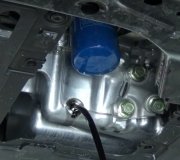Grinding When Braking
This is one of the most popular grinding noises that can occur, this noise can be generated whether the brakes are being used or not. When the brake pads or shoes have worn past their usability it will allow the metal backing plate of the pad or shoe to contact the brake rotor or drum, this is what creates the noise which means the brake pads (front grinding) or brake shoes (rear grinding) need to be replaced. Our experts can give you car specific instructions for free from the AllData or Mitchell1 online repair manuals to do the job.
Car is Constantly Grinding
Do you hear grinding sounds when the car is just rolling along, also does it change pitch when you turn a corner? This is because you have an axle bearing or bearing hub that has failed and the bearing material is being ground up which produces the noise. Try to tell where the noise is being generated from, either the front or rear of the car. You might want to have a helper ride along in a rear seat to give a different perspective on the origin of the grinding noise. The rear noise means you have a rear axle bearing that needs to be replaced, while the noise in the front indicates a front bearing hub is bad and needs replacement.
Grinding Engine
Typically when an automotive engine creates a grinding sound it is usually a front engine accessory such as an alternator, water pump or belt tensioner pulley. These are easily changed out once you remove the serpentine belt, this will allow each accessory pulley to be spun helping to detect which one is grinding and needs replacement. If you think the noise is internal, once the serpentine belt is removed start the engine to see if the noise is gone, if so the noise is an accessory, if not the noise is internal such as a worn timing chain or broken timing chain guide.
Steering is Grinding
Do you hear grinding when you steer the car? A steering system can make a grinding noise when the power steering fluid is low which is created when the pump scavenges for fluid but takes in air, this problem is easily fixed by checking the power steering fluid.
Starter Motor Grinds
When you turn the ignition key to the crank position do you hear a loud grinding noise? This is because the battery is weak which hinders the starter's operation. To confirm this issue you can do a battery load test which is easy because you don't need any tools, simply turn the headlights on for a short time and then try to use the starter with the headlights on, if everything goes out the battery is no good and needs replacement. If the battery is good and the starter still grinds the starter motor is bad and needs replacement.
Transmission Grind
Usually an automatic transmission will not grind, this is not true for a manual transmission. There are two ways a standard transmission will grind, either the clutch is not working which forces a grinding noise when trying to select a gear, or the transmission itself has an issue internally. Most of the time the clutch is to blame because the clutch disc falls apart not allowing the clutch to be disengaged.
Automotive metal grinding noises can indicate a serious issue in your car. Here's how to identify the cause and fix it to ensure a smoother and safer ride.
Step 1: Identify the Source of the Noise
Isolate the noise's location by paying close attention to when and where the sound occurs. Is it coming from the front or rear? Does it happen when you brake, accelerate, or turn? Noting these details can help identify the issue.
Step 2: Inspect the Brakes
Grinding noises often come from the braking system. Check your brake pads for wear. If they're worn down past the indicator, they'll need replacing.
Step 3: Check the Wheel Bearings
Bad wheel bearings can also cause grinding noises. Test this by lifting your car with a jack, then grabbing the top and bottom of the tire and rocking it. If it moves more than a few millimeters, the bearing may need replacing.
Step 4: Inspect the Power Steering System
If the noise occurs when you turn the steering wheel, your power steering system could be the culprit. Check the power steering fluid level and top it up if needed. If the noise persists, you might have a worn-out power steering pump.
Step 5: Look at the Drive Belts and Pulleys
Worn-out drive belts or pulleys can also cause grinding noises. Check for wear or damage and replace them if necessary.
Step 6: Consult a Mechanic
If you can't identify the source of the noise or it's a component you're not comfortable working on, consult a professional mechanic. They have the tools and experience to diagnose and fix the issue.
Conclusion
Ignoring a grinding noise can lead to serious damage and costly repairs. By following this guide, you can identify and resolve the issue before it worsens. Remember, if in doubt, always consult a professional mechanic.
Disclaimer
This guide is meant to assist you in identifying potential issues. Working on a car, especially the braking system, can be dangerous if not done properly. Always consult a professional mechanic if you're unsure.
Questions?
Our certified technicians are ready to answer car grinding questions for free (please upload a video of the noise). We hope you saved money and learned from this guide. We are creating a full set of car repair guides. Please subscribe to our 2CarPros YouTube channel and check back often for new videos which are uploaded regularly.


